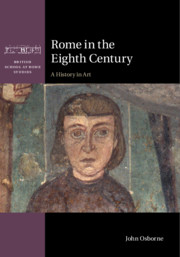Book contents
- Rome in the Eighth Century
- British School at Rome Studies
- Rome in the Eighth Century
- Copyright page
- Contents
- Figures
- Plates
- Acknowledgements
- Abbreviations
- Preface
- 1 Rome in 700: ‘Constantinople on the Tiber’
- 2 Pope John VII servus sanctae Mariae
- 3 Clerics, Monks and Pilgrims
- 4 ‘The City of the Church’
- 5 The Chapel of Theodotus in Santa Maria Antiqua
- 6 Pope Zacharias and the Lateran Palace
- 7 Rome and the Franks
- 8 Paul I
- 9 Hadrian I dux Dei
- 10 Leo III and Charlemagne
- Afterword
- Bibliography
- Index
- Plate Section
5 - The Chapel of Theodotus in Santa Maria Antiqua
Published online by Cambridge University Press: 11 June 2020
- Rome in the Eighth Century
- British School at Rome Studies
- Rome in the Eighth Century
- Copyright page
- Contents
- Figures
- Plates
- Acknowledgements
- Abbreviations
- Preface
- 1 Rome in 700: ‘Constantinople on the Tiber’
- 2 Pope John VII servus sanctae Mariae
- 3 Clerics, Monks and Pilgrims
- 4 ‘The City of the Church’
- 5 The Chapel of Theodotus in Santa Maria Antiqua
- 6 Pope Zacharias and the Lateran Palace
- 7 Rome and the Franks
- 8 Paul I
- 9 Hadrian I dux Dei
- 10 Leo III and Charlemagne
- Afterword
- Bibliography
- Index
- Plate Section
Summary
Examines the murals in the best-preserved chapel in S anta Maria Antiqua, dating from the time of Pope Zacharias (741–52) and dedicated to Saints Quiricus and Julitta. The chapel is important as being the first early medieval example of lay patronage in Rome, and the focus of discussion is the donor, Theodotus, named in the painted inscriptions and depicted with other members of his family, a former military commander who switched to papal service and also played a major role in the development of the ‘idiaconiae’ (welfare stations). A case is presented for the hellenophone origins of the family, our best documented example of Rome’s new landowning élite.
- Type
- Chapter
- Information
- Rome in the Eighth CenturyA History in Art, pp. 95 - 136Publisher: Cambridge University PressPrint publication year: 2020

